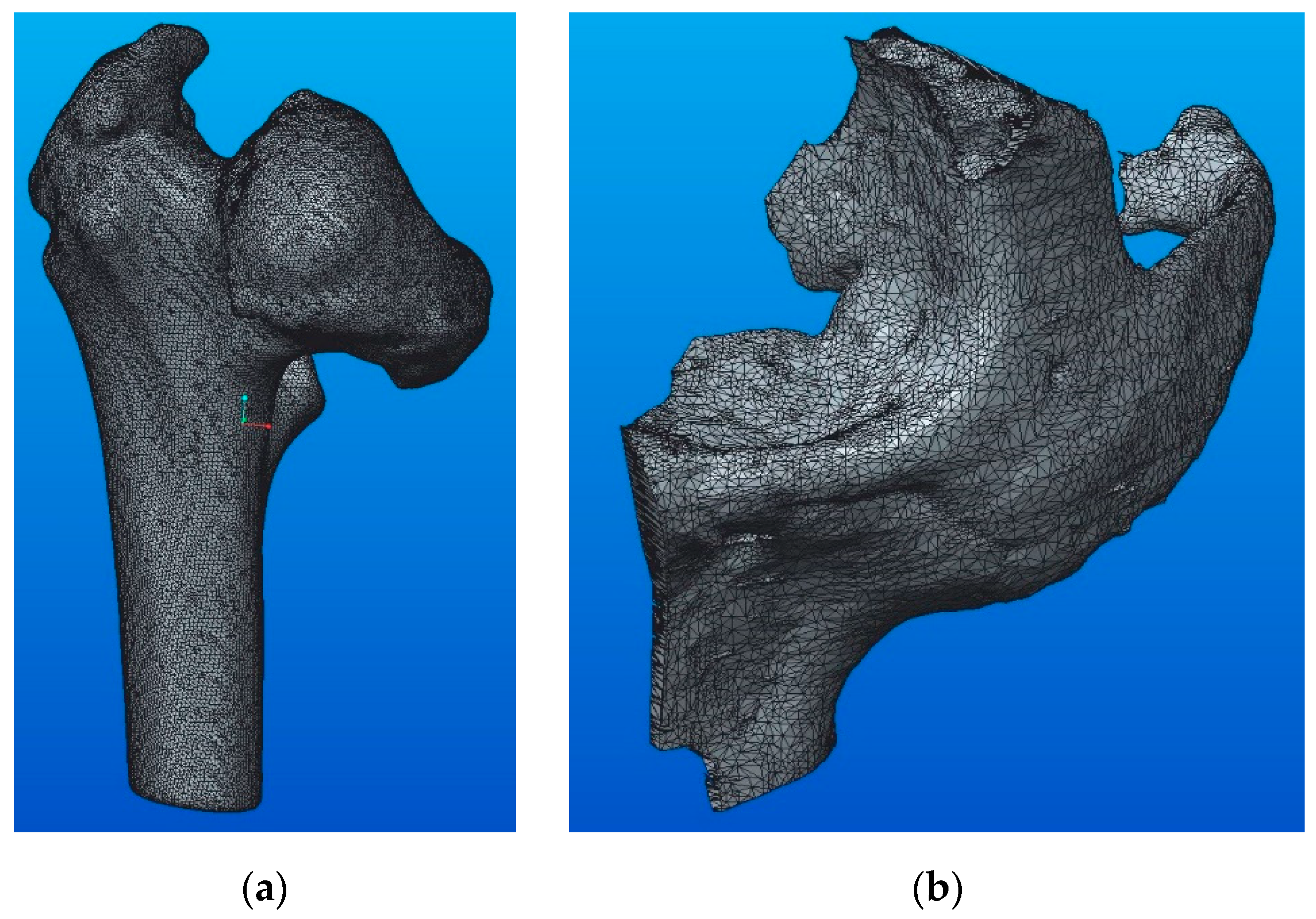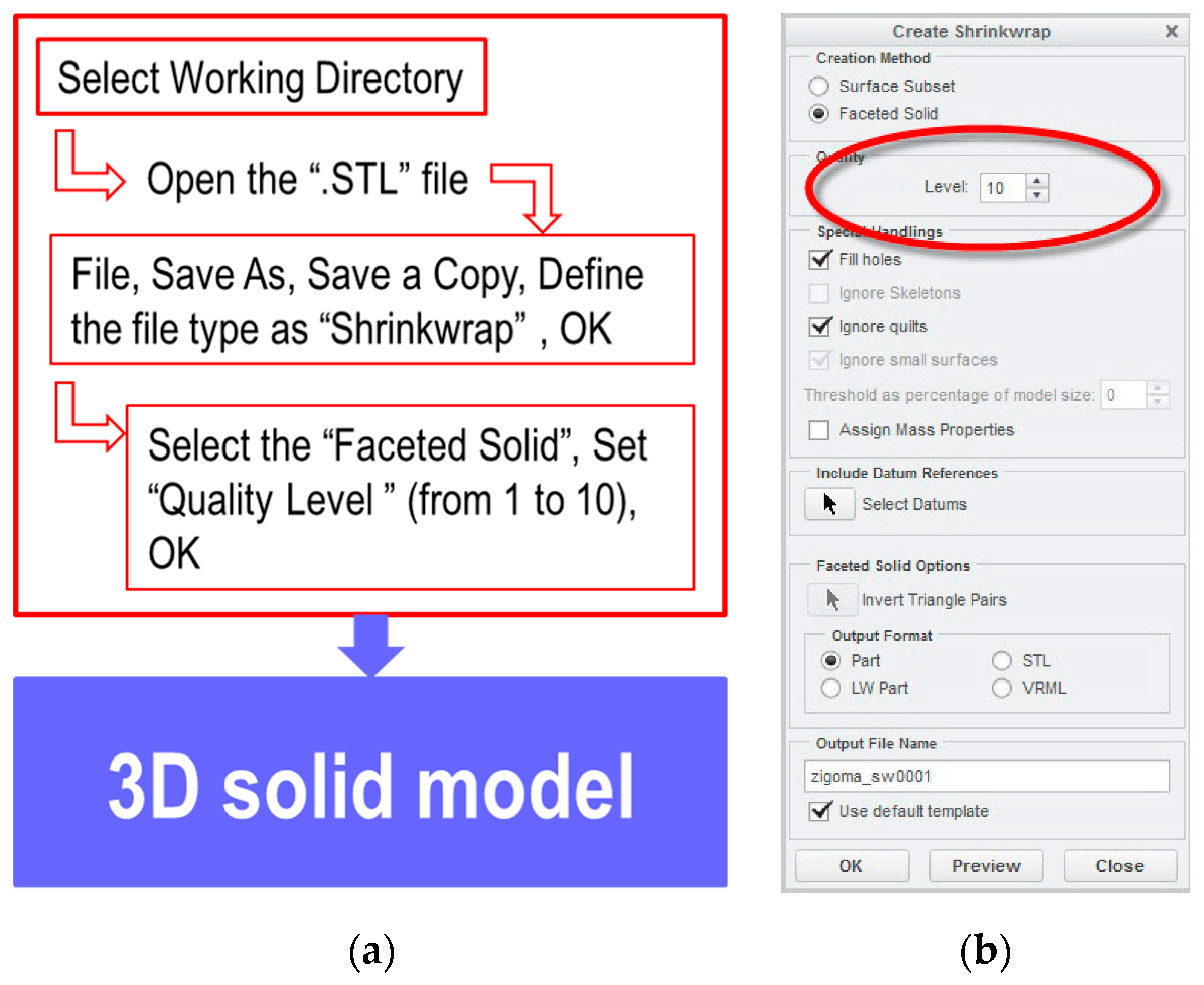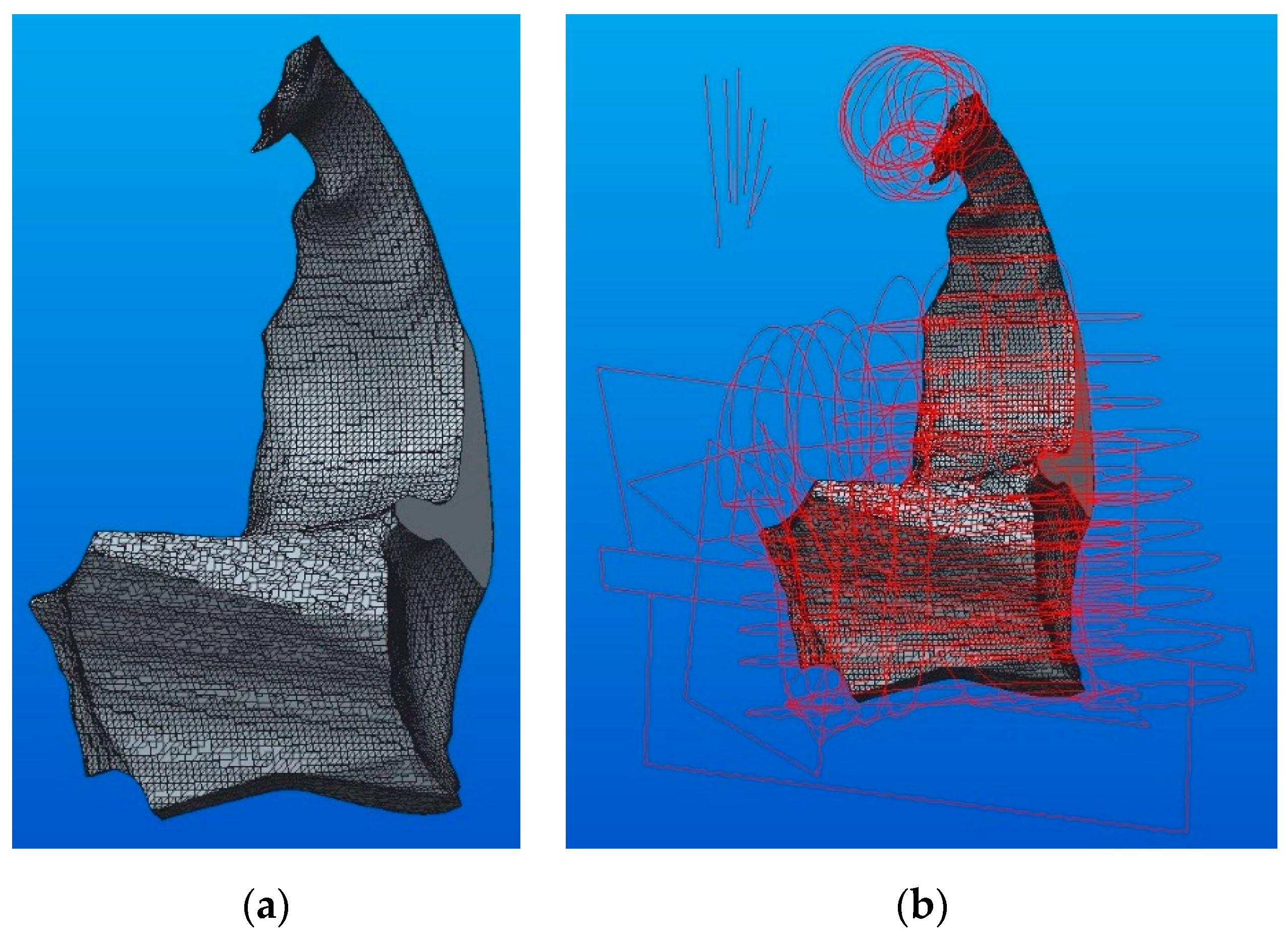Generation of Computational 3D Models of Human Bones Based on STL Data and CAD Software Packages
Abstract
1. Introduction
2. Working Condition
3. Conversion Methods
3.1. Conversion Methods Using CATIA Functions
3.2. Conversion Methods Using Creo Parametric Functions
3.3. Conversion Methods Using Geometric Modeling in Creo Parametric
4. Results
5. Conclusions
6. Patents
Author Contributions
Funding
Institutional Review Board Statement
Informed Consent Statement
Data Availability Statement
Acknowledgments
Conflicts of Interest
References
- Chung-Shing, W.; Wei-Hua, A.W.; Man-Ching, L. STL rapid prototyping bio-CAD model for CT medical image segmentation. Comput. Ind. 2010, 61, 187–197. [Google Scholar]
- Lee, T.-Y.; Lin, C.-H. Feature-guided shape-based image interpolation. IEEE Trans. Med. Imaging 2002, 21, 1479–1489. [Google Scholar] [CrossRef] [PubMed]
- Rajon, D.; Bolch, W. Marching cube algorithm: Review and trilinear interpolation adaptation for image-based dosimetric models. Comput. Med. Imaging Graph. 2003, 27, 411–435. [Google Scholar] [CrossRef]
- Warkhedkar, R.M.; Bhatt, A.D. Material-solid modeling of human body: A heterogeneous B-spline based approach. Comput. Des. 2009, 41, 586–597. [Google Scholar] [CrossRef]
- Majstorovic, V.; Trajanovic, M.; Vitkovic, N.; Stojkovic, M. Reverse engineering of human bones by using method of anatomical features. CIRP Ann. 2013, 62, 167–170. [Google Scholar] [CrossRef]
- Yoo, D.-J. Three-dimensional surface reconstruction of human bone using a B-spline based interpolation approach. Comput. Des. 2011, 43, 934–947. [Google Scholar] [CrossRef]
- Yuwen, S.; Dongming, G.; Zhenyuan, J.; Weijun, L. B-spline surface reconstruction and direct slicing from point clouds. Int. J. Adv. Manuf. Technol. 2006, 27, 918–924. [Google Scholar] [CrossRef]
- Yin, Z. Direct generation of extended STL file from unorganized point data. Comput. Des. 2011, 43, 699–706. [Google Scholar] [CrossRef]
- Shuming, G.; Wei, Z.; Hongwei, L.; Fanqin, Y.; Xiang, C. Feature suppression based CAD mesh model simplification. Comput. -Aided Des. 2010, 42, 1178–1188. [Google Scholar]
- Rypl, D.; Bittnar, Z. Generation of computational surface meshes of STL models. J. Comput. Appl. Math. 2006, 192, 148–151. [Google Scholar] [CrossRef]
- Hutton, D.V. Fundamentals of Finite Element Analysis; McGraw-Hill: New York, NY, USA, 2004. [Google Scholar]
- Chen, X. Reconstruction individual three-dimensional model of fractured long bone based on feature points. Comp. Appl. Math. 2020, 39, 1–14. [Google Scholar] [CrossRef]
- Park, S.C. Sculptured surface machining using triangular mesh slicing. Comput. -Aided Des. 2004, 36, 279–288. [Google Scholar] [CrossRef]
- Pandey, P.; Reddy, N.V.; Dhande, S. Real time adaptive slicing for fused deposition modelling. Int. J. Mach. Tools Manuf. 2003, 43, 61–71. [Google Scholar] [CrossRef]
- Ivan, N.V.; Berce, P.; Dragoi, M.V.; Oancea, G.; Ivan, M.C.; Bâlc, N.; Lancea, C.; Udroiu, R.; Vasiloni, M.; Mihail, M.; et al. CAD/CAPP/CAM Systems: Theory and Applications; Tehnică Publishing House: Bucharest, Romania, 2004. [Google Scholar]
- Przemysław, G.; Paweł, W. Merging of Bézier curves with box constraints. J. Comput. Appl. Math. 2016, 296, 265–274. [Google Scholar]
- Sánchez-Reyes, J. Detecting symmetries in polynomial Bézier curves. J. Comput. Appl. Math. 2015, 288, 274–283. [Google Scholar] [CrossRef]
- Delgado, J.; Peña, J. Accurate evaluation of Bézier curves and surfaces and the Bernstein-Fourier algorithm. Appl. Math. Comput. 2015, 271, 113–122. [Google Scholar] [CrossRef][Green Version]
- Leordean, D.; Dudescu, C.; Marcu, T.; Berce, P.; Bâlc, N.; Dudescu, M.C. Customized implants with specific properties, made by selective laser melting. Rapid Prototyp. J. 2015, 21, 98–104. [Google Scholar] [CrossRef]


















| CAD Software | Tetrahedral Elements | Edges | Nodes | Facets |
|---|---|---|---|---|
| CATIA model | 254,886 | 41,826 | 8739 | 58,574 |
| Creo Parametric model | 11,324 | 16,148 | 2933 | 24,540 |
| CAD Software | Total Time [s] | CPU Time [s] | RAM Usage [kB] | Disk Space Usage [kB] |
|---|---|---|---|---|
| CATIA model | 295.21 | 330.13 | 1,281,335 | 1,477,632 |
| Creo Parametric model | 72.82 | 129.86 | 878,993 | 967,680 |
Publisher’s Note: MDPI stays neutral with regard to jurisdictional claims in published maps and institutional affiliations. |
© 2021 by the authors. Licensee MDPI, Basel, Switzerland. This article is an open access article distributed under the terms and conditions of the Creative Commons Attribution (CC BY) license (https://creativecommons.org/licenses/by/4.0/).
Share and Cite
Leordean, D.; Vilău, C.; Dudescu, M.C. Generation of Computational 3D Models of Human Bones Based on STL Data and CAD Software Packages. Appl. Sci. 2021, 11, 7964. https://doi.org/10.3390/app11177964
Leordean D, Vilău C, Dudescu MC. Generation of Computational 3D Models of Human Bones Based on STL Data and CAD Software Packages. Applied Sciences. 2021; 11(17):7964. https://doi.org/10.3390/app11177964
Chicago/Turabian StyleLeordean, Dan, Cristian Vilău, and Mircea Cristian Dudescu. 2021. "Generation of Computational 3D Models of Human Bones Based on STL Data and CAD Software Packages" Applied Sciences 11, no. 17: 7964. https://doi.org/10.3390/app11177964
APA StyleLeordean, D., Vilău, C., & Dudescu, M. C. (2021). Generation of Computational 3D Models of Human Bones Based on STL Data and CAD Software Packages. Applied Sciences, 11(17), 7964. https://doi.org/10.3390/app11177964







